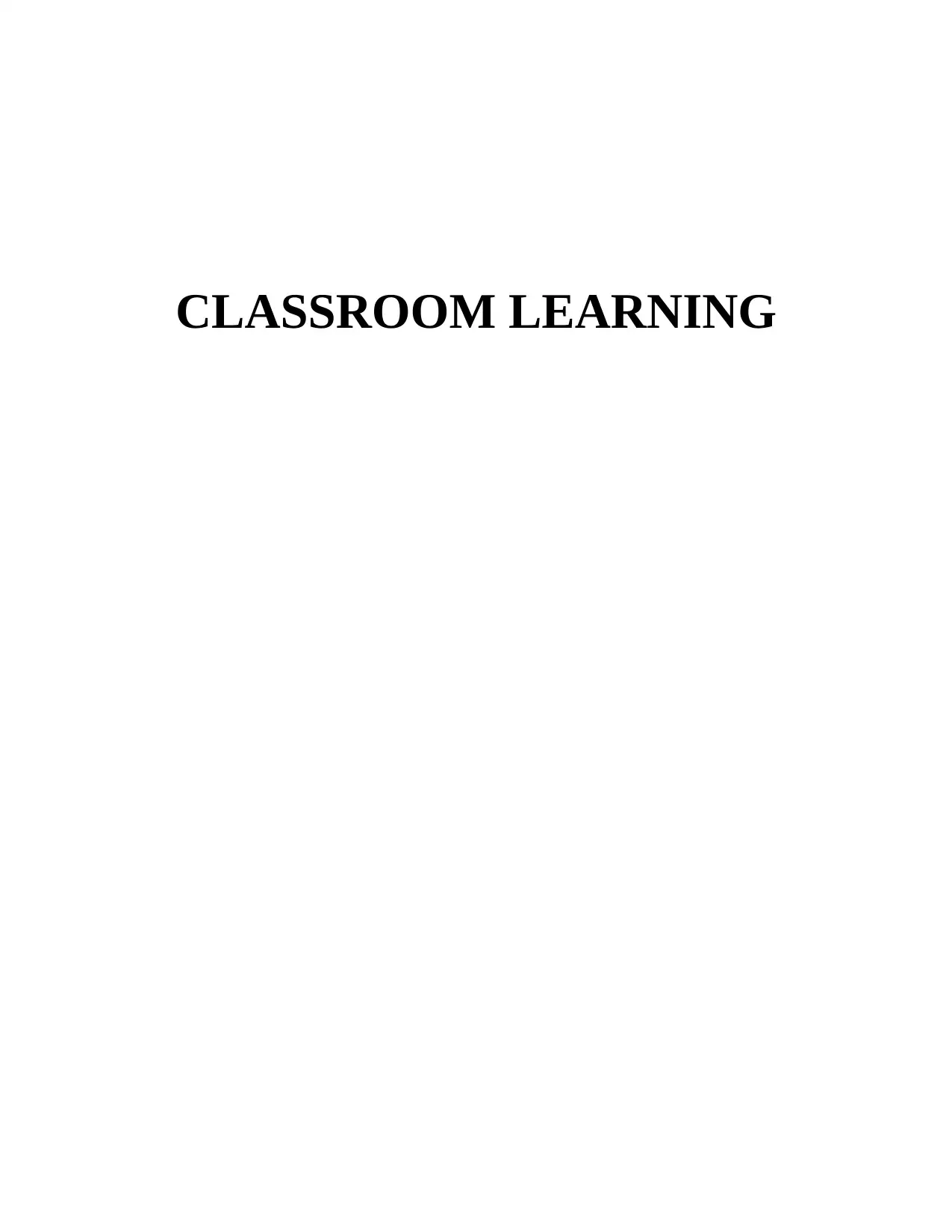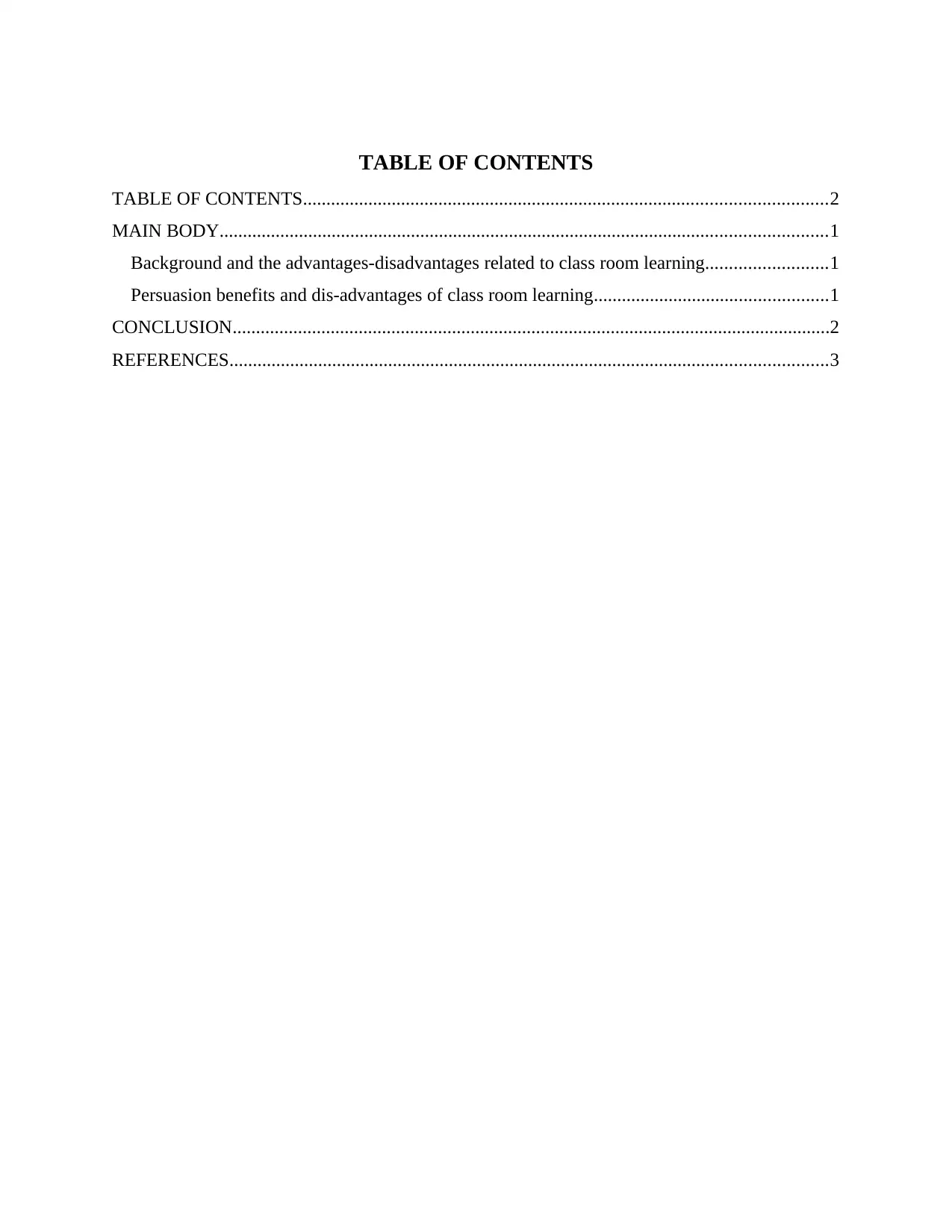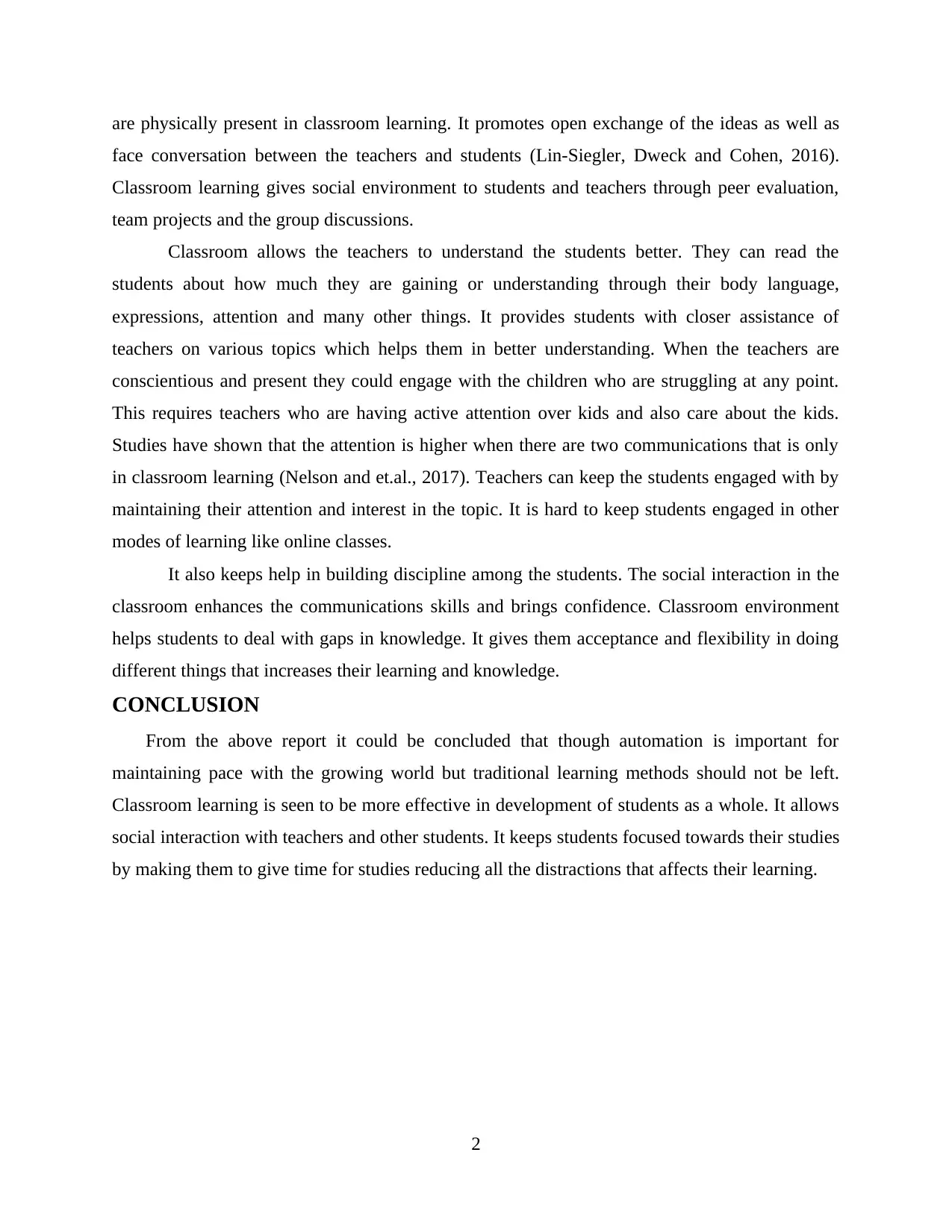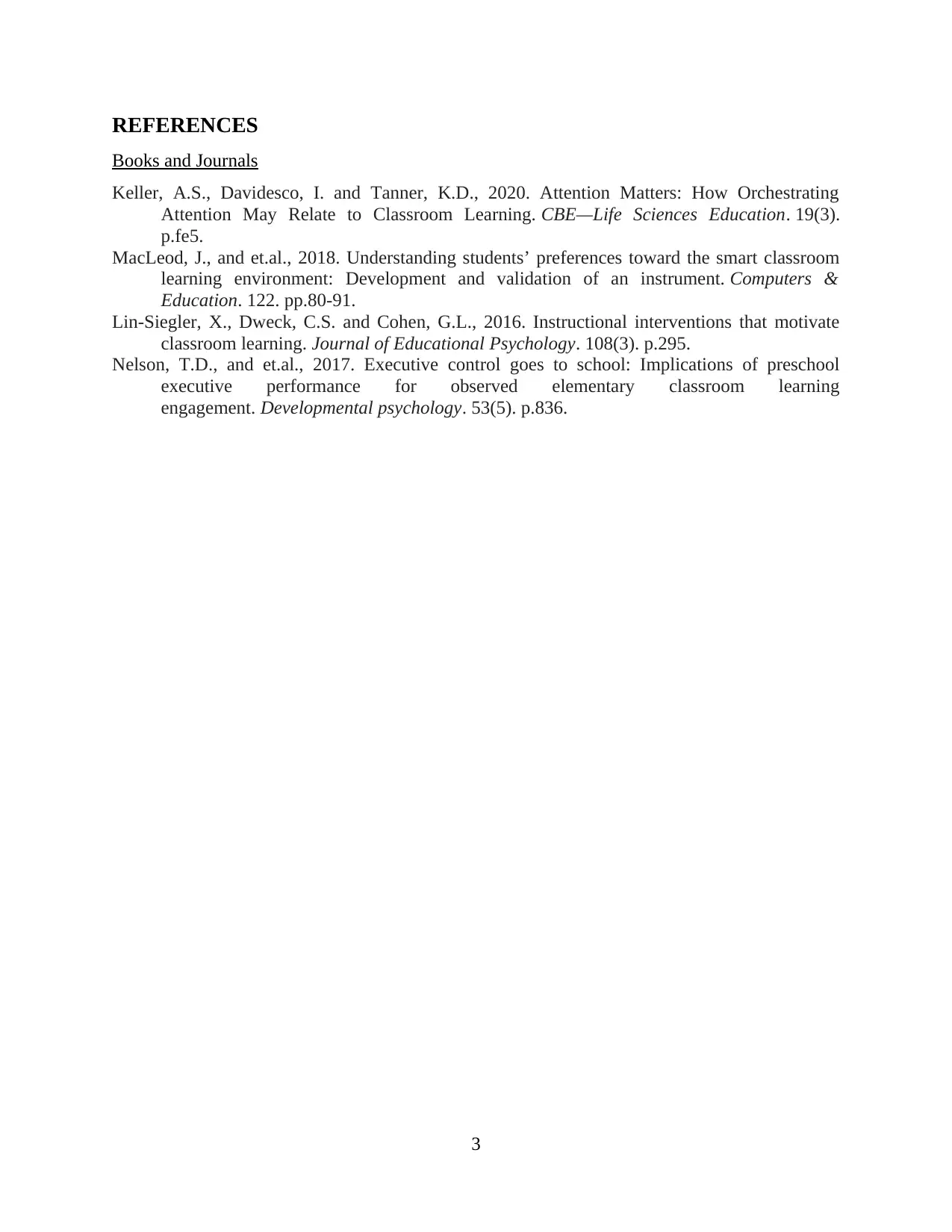Classroom Learning: Advantages, Disadvantages, and Persuasion Report
VerifiedAdded on 2022/12/30
|5
|970
|31
Report
AI Summary
This report provides an overview of classroom learning, contrasting it with online learning methods. It begins with a historical background, tracing the evolution of classroom settings and their impact on students' knowledge development. The report then delves into the advantages and disadvantages of classroom learning, including the benefits of social interaction, teacher-student engagement, and improved communication skills. It also highlights the role of classroom learning in fostering student discipline and addressing knowledge gaps. The report concludes that while technological advancements are important, traditional classroom methods are vital for holistic student development.

CLASSROOM LEARNING
Paraphrase This Document
Need a fresh take? Get an instant paraphrase of this document with our AI Paraphraser

TABLE OF CONTENTS
TABLE OF CONTENTS................................................................................................................2
MAIN BODY..................................................................................................................................1
Background and the advantages-disadvantages related to class room learning..........................1
Persuasion benefits and dis-advantages of class room learning..................................................1
CONCLUSION................................................................................................................................2
REFERENCES................................................................................................................................3
TABLE OF CONTENTS................................................................................................................2
MAIN BODY..................................................................................................................................1
Background and the advantages-disadvantages related to class room learning..........................1
Persuasion benefits and dis-advantages of class room learning..................................................1
CONCLUSION................................................................................................................................2
REFERENCES................................................................................................................................3

MAIN BODY
Background and the advantages-disadvantages related to class room learning
In the present era of automation, the changes are seen in every field be it production or
education. Everything with its invent brings some benefits and opportunities while drawbacks
with the same. The methods of learning are also changing with time from traditional classroom
learning to online classes. The innovation is good but it does not mean that traditional methods
are not effective or essential (Keller, Davidesco and Tanner, 2020). Classroom learning provides
the students with better knowledge and deeper insights. The present report will discuss about
classroom learning and its benefits for the students. It will provide a background on the
classroom studies how it was and how it is now as per the current trends. The impact of
classroom learning is more over the students and results in better learning and development of
their knowledge. The topic has been chosen as students are losing their attention and focusing
more over comfortable e-learning which is prone to number of distractions.
Classroom is described as learning space where both adults or children learn. They are
mainly found in the educational institutions which could be schools pr universities and other
places where education and training are provided. Before the invent of structural building
students were taught in the open areas. With the time the space for learning or teaching were
developed. The classroom learning is the old method of giving knowledge and educating them. It
was started with teachings on religion (MacLeod and et.al., 2018). The changing environment
brought continuous development to the classroom learning. It enables students to learn and ask
for the doubts at the same time. This developed the learning and thinking skills of the students.
They were allowed to think out of box and to understand things by better guidance.
It has been considered that classroom learning develops the mind of students where the
online learning forces the students over particular directions. They are lacking practical exposure
and learning. The interaction between teachers and students has been reduced to considerable
extent which will affect the growth of student. The traditional learning system helps in overall
development of the students from mental to physical and prepares them for various challenges of
life.
Persuasion benefits and dis-advantages of class room learning
Classroom learning encompasses merits of setting a classroom. It requires certain number
of students or participants who are active participants in that environment. Teachers and students
1
Background and the advantages-disadvantages related to class room learning
In the present era of automation, the changes are seen in every field be it production or
education. Everything with its invent brings some benefits and opportunities while drawbacks
with the same. The methods of learning are also changing with time from traditional classroom
learning to online classes. The innovation is good but it does not mean that traditional methods
are not effective or essential (Keller, Davidesco and Tanner, 2020). Classroom learning provides
the students with better knowledge and deeper insights. The present report will discuss about
classroom learning and its benefits for the students. It will provide a background on the
classroom studies how it was and how it is now as per the current trends. The impact of
classroom learning is more over the students and results in better learning and development of
their knowledge. The topic has been chosen as students are losing their attention and focusing
more over comfortable e-learning which is prone to number of distractions.
Classroom is described as learning space where both adults or children learn. They are
mainly found in the educational institutions which could be schools pr universities and other
places where education and training are provided. Before the invent of structural building
students were taught in the open areas. With the time the space for learning or teaching were
developed. The classroom learning is the old method of giving knowledge and educating them. It
was started with teachings on religion (MacLeod and et.al., 2018). The changing environment
brought continuous development to the classroom learning. It enables students to learn and ask
for the doubts at the same time. This developed the learning and thinking skills of the students.
They were allowed to think out of box and to understand things by better guidance.
It has been considered that classroom learning develops the mind of students where the
online learning forces the students over particular directions. They are lacking practical exposure
and learning. The interaction between teachers and students has been reduced to considerable
extent which will affect the growth of student. The traditional learning system helps in overall
development of the students from mental to physical and prepares them for various challenges of
life.
Persuasion benefits and dis-advantages of class room learning
Classroom learning encompasses merits of setting a classroom. It requires certain number
of students or participants who are active participants in that environment. Teachers and students
1
⊘ This is a preview!⊘
Do you want full access?
Subscribe today to unlock all pages.

Trusted by 1+ million students worldwide

are physically present in classroom learning. It promotes open exchange of the ideas as well as
face conversation between the teachers and students (Lin-Siegler, Dweck and Cohen, 2016).
Classroom learning gives social environment to students and teachers through peer evaluation,
team projects and the group discussions.
Classroom allows the teachers to understand the students better. They can read the
students about how much they are gaining or understanding through their body language,
expressions, attention and many other things. It provides students with closer assistance of
teachers on various topics which helps them in better understanding. When the teachers are
conscientious and present they could engage with the children who are struggling at any point.
This requires teachers who are having active attention over kids and also care about the kids.
Studies have shown that the attention is higher when there are two communications that is only
in classroom learning (Nelson and et.al., 2017). Teachers can keep the students engaged with by
maintaining their attention and interest in the topic. It is hard to keep students engaged in other
modes of learning like online classes.
It also keeps help in building discipline among the students. The social interaction in the
classroom enhances the communications skills and brings confidence. Classroom environment
helps students to deal with gaps in knowledge. It gives them acceptance and flexibility in doing
different things that increases their learning and knowledge.
CONCLUSION
From the above report it could be concluded that though automation is important for
maintaining pace with the growing world but traditional learning methods should not be left.
Classroom learning is seen to be more effective in development of students as a whole. It allows
social interaction with teachers and other students. It keeps students focused towards their studies
by making them to give time for studies reducing all the distractions that affects their learning.
2
face conversation between the teachers and students (Lin-Siegler, Dweck and Cohen, 2016).
Classroom learning gives social environment to students and teachers through peer evaluation,
team projects and the group discussions.
Classroom allows the teachers to understand the students better. They can read the
students about how much they are gaining or understanding through their body language,
expressions, attention and many other things. It provides students with closer assistance of
teachers on various topics which helps them in better understanding. When the teachers are
conscientious and present they could engage with the children who are struggling at any point.
This requires teachers who are having active attention over kids and also care about the kids.
Studies have shown that the attention is higher when there are two communications that is only
in classroom learning (Nelson and et.al., 2017). Teachers can keep the students engaged with by
maintaining their attention and interest in the topic. It is hard to keep students engaged in other
modes of learning like online classes.
It also keeps help in building discipline among the students. The social interaction in the
classroom enhances the communications skills and brings confidence. Classroom environment
helps students to deal with gaps in knowledge. It gives them acceptance and flexibility in doing
different things that increases their learning and knowledge.
CONCLUSION
From the above report it could be concluded that though automation is important for
maintaining pace with the growing world but traditional learning methods should not be left.
Classroom learning is seen to be more effective in development of students as a whole. It allows
social interaction with teachers and other students. It keeps students focused towards their studies
by making them to give time for studies reducing all the distractions that affects their learning.
2
Paraphrase This Document
Need a fresh take? Get an instant paraphrase of this document with our AI Paraphraser

REFERENCES
Books and Journals
Keller, A.S., Davidesco, I. and Tanner, K.D., 2020. Attention Matters: How Orchestrating
Attention May Relate to Classroom Learning. CBE—Life Sciences Education. 19(3).
p.fe5.
MacLeod, J., and et.al., 2018. Understanding students’ preferences toward the smart classroom
learning environment: Development and validation of an instrument. Computers &
Education. 122. pp.80-91.
Lin-Siegler, X., Dweck, C.S. and Cohen, G.L., 2016. Instructional interventions that motivate
classroom learning. Journal of Educational Psychology. 108(3). p.295.
Nelson, T.D., and et.al., 2017. Executive control goes to school: Implications of preschool
executive performance for observed elementary classroom learning
engagement. Developmental psychology. 53(5). p.836.
3
Books and Journals
Keller, A.S., Davidesco, I. and Tanner, K.D., 2020. Attention Matters: How Orchestrating
Attention May Relate to Classroom Learning. CBE—Life Sciences Education. 19(3).
p.fe5.
MacLeod, J., and et.al., 2018. Understanding students’ preferences toward the smart classroom
learning environment: Development and validation of an instrument. Computers &
Education. 122. pp.80-91.
Lin-Siegler, X., Dweck, C.S. and Cohen, G.L., 2016. Instructional interventions that motivate
classroom learning. Journal of Educational Psychology. 108(3). p.295.
Nelson, T.D., and et.al., 2017. Executive control goes to school: Implications of preschool
executive performance for observed elementary classroom learning
engagement. Developmental psychology. 53(5). p.836.
3
1 out of 5
Related Documents
Your All-in-One AI-Powered Toolkit for Academic Success.
+13062052269
info@desklib.com
Available 24*7 on WhatsApp / Email
![[object Object]](/_next/static/media/star-bottom.7253800d.svg)
Unlock your academic potential
Copyright © 2020–2025 A2Z Services. All Rights Reserved. Developed and managed by ZUCOL.




